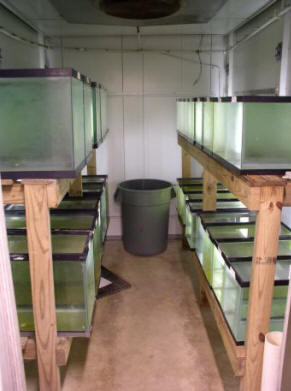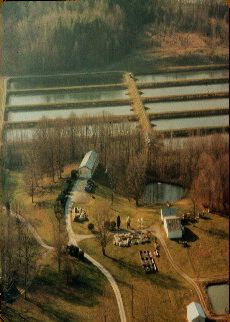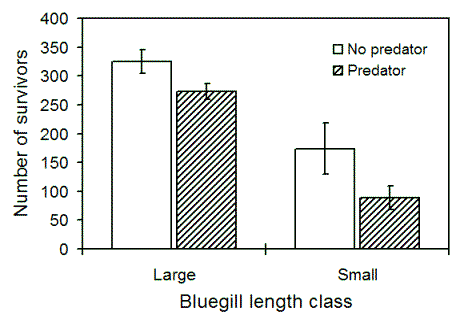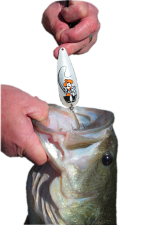Overwinter Survival of Age-0 Bluegill
This page describes two projects investigating size-specific overwinter survival of bluegill.
The Effect of Temperature and Food Availability on Size-Specific Overwinter Survival in Age-0 Bluegill
Project personnel: Dan Shoup, Dave Wahl
Shoup, D.E., and Wahl, D.H. 2011. Body size, food, and temperature affect overwinter survival of age-0 bluegill. Transactions of the American Fisheries Society 140:1298-1304.

Fish with protracted spawning often have high variability in length of age-0 fish in fall. Several studies from northern climates have found that early-spawned bluegill Lepomis macrochirus, which are larger and therefore have greater energy reserves going into winter, have greater overwinter survival than their smaller late-spawned cohorts. However, other studies investigating bluegill populations at lower latitudes have found that overwinter survival is not size-selective. To examine the interaction of size and winter severity on overwinter survival, we performed an experiment (2 x 2 x 2 factorial) with two size classes (20-30 mm and 50-60 mm) of age-0 bluegill held at two temperatures overwinter (9o C and 4o C), with or without food. Bluegill were housed in groups of 10 (n=6 replicates) in aquaria within environmental chambers.
Survival, growth, and condition factor were higher for fed than starved fish at both temperatures. Survival, growth, and condition factor were highest for fed fish at 9o C, intermediate for both fed and unfed fish at 4o C, and lowest for 9o C starved fish. Large fish had similar survival to small fish when fed, but large fish had higher survival than small fish when they were starved. Activity levels during the experiment were highest for fed fish held at 9o C. Activity levels were similar for unfed fish at 9o C and fed fish at 4o C; unfed fish at 4o C had the lowest activity level. Fall and spring bluegill collected from 10 lakes in Illinois indicated that the pattern of overwinter mortality is highly variable among systems. We propose that winter food availability and winter severity interact to determine the extent of size-specific mortality experienced by age-0 bluegill in natural systems.

The Effect of Largemouth Bass Predation on Overwinter Survival of Two Size-Classes of Age-0 Bluegills
Project personnel: Dan Shoup, Dave Wahl
Shoup, D.E., and D.H. Wahl. 2008. The effect of largemouth bass predation on overwinter survival of two length classes of age-0 bluegill. Transactions of the American Fisheries Society. Transactions of the American Fisheries Society 137:1063–1071.

Overwinter mortality is an important force structuring year-class strength of many fishes. Conventional wisdom is that overwinter mortality is primarily caused by starvation; however, recent research has demonstrated that piscivores continue to feed during winter and may also contribute to overwinter mortality of their prey populations. We conducted experiments in ten 0.04-ha earthen ponds in central Illinois to assess the effect of predation by largemouth bass Micropterus salmoides on survival of two size-classes (20–30 and 40–65 mm total length [TL]) of age-0 bluegills Lepomis macrochirus. Bluegills (400 fish/size class) were stocked into each pond at the end of November. Half of the ponds also received five small (90–124 mm TL) and four large (166–192 mm TL) largemouth bass.
Survival to the end of the 113-d experiment was higher for large bluegills than for small bluegills in all ponds. For both bluegill size-classes, the predator-present treatment had higher mortality than the predator-free treatment. Relative to the predator free treatment, mortality of bluegills in the predator-present treatment increased by 16% for the large size class and 49% for the small size-class. Mean length and relative condition (Kn) of both bluegill size-classes increased by the end of the experiment in both treatments, suggesting that the observed mortality was not caused by starvation. Further exploration is needed to elucidate why bluegills in the predator-free treatment suffered overwinter mortality despite the increase in Kn during the experiment. Length and Kn of largemouth bass increased (large size-class) or stayed the same (small size-class), suggesting that at least some of the predators foraged during winter. Our results indicate that size-specific overwinter mortality of bluegills occurs at the middle latitudes of the species’ range. Further, winter predation can be an important component influencing size-specific overwinter survival and size-structured interactions between fishes.



